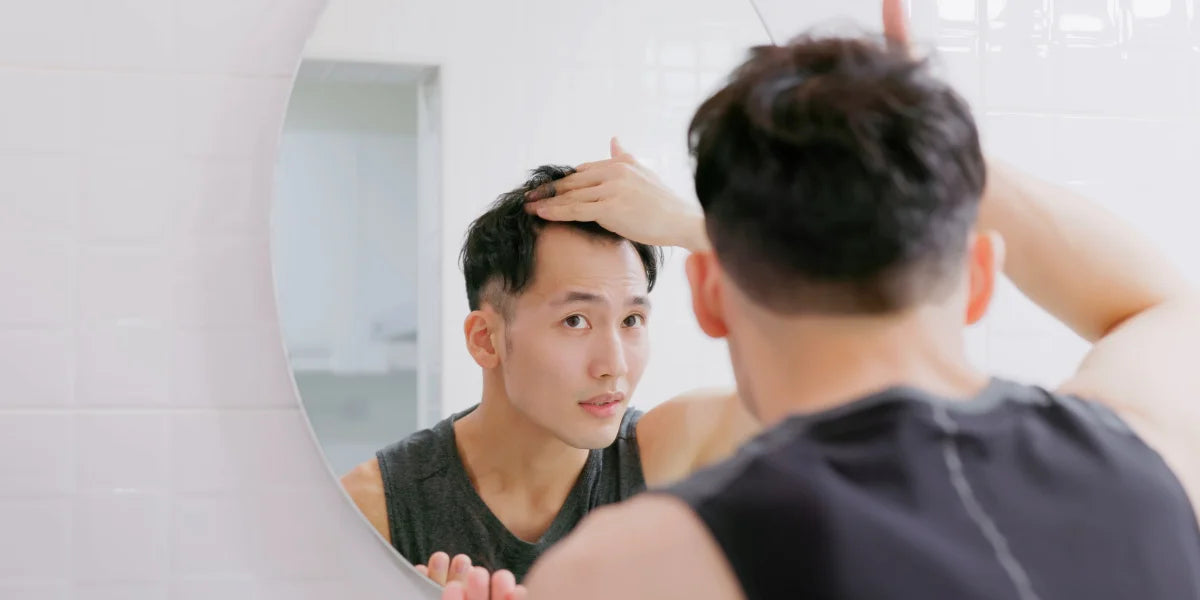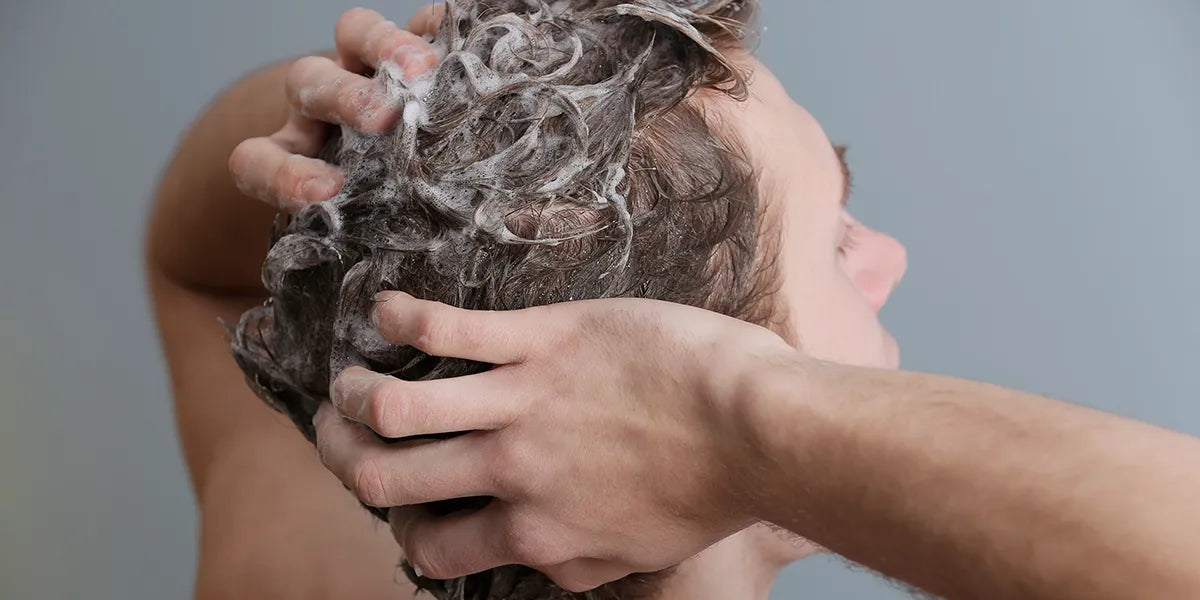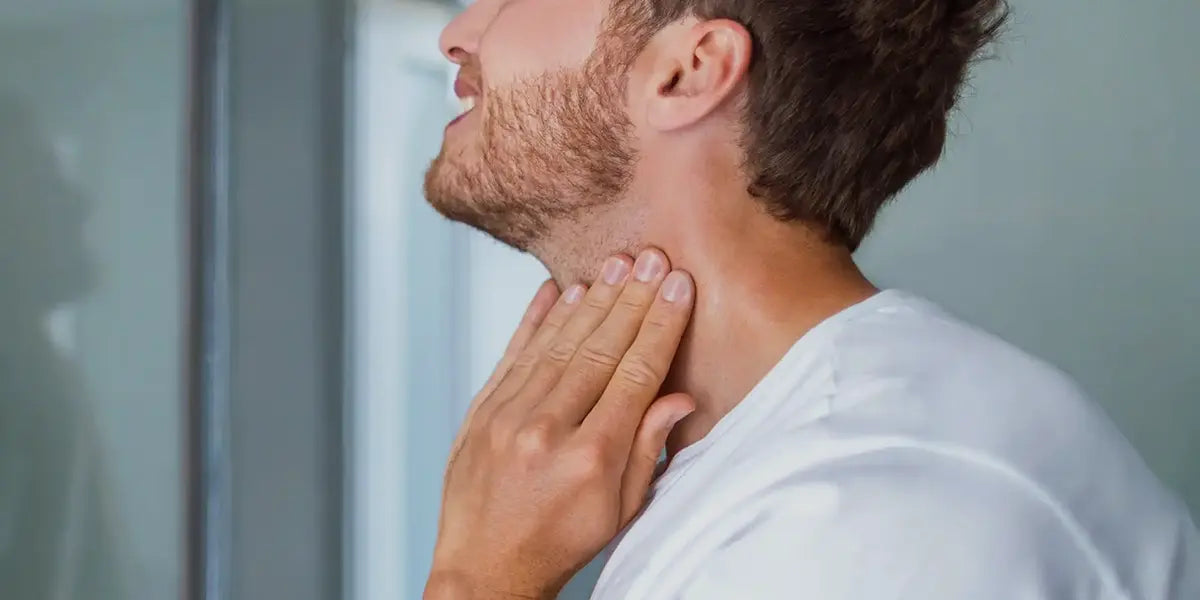Androgens (also known as male sex steroid hormones) play an important role in the maintenance of optimal health in males. But there’s been speculation that androgens like testosterone contribute to hair loss. Is there any truth to this and should you be worried about taking a treatment like testosterone replacement therapy? Let’s take a closer look at how hair growth is influenced by hormones, what causes balding and whether testosterone replacement therapy (or TRT) might put you at higher risk for developing hair loss.
Does testosterone cause hair loss?
Testosterone doesn’t directly cause hair loss. In fact, the primary cause of androgenetic hair loss is a hormone called dihydrotestosterone (DHT), which is related to testosterone. This chemical reaction is possible thanks to an enzyme called 5-alpha reductase, which converts testosterone to DHT.
Your genetics dictate when you’ll start to lose your hair, as well as how severe or quickly your hair loss will progress. At the hair follicle level, DHT can cause the follicle to shrink, changing its structure in a way that disrupts proper hair growth cycling. This process is called follicular miniaturization and is believed to be impacted by how sensitive follicles are to DHT.
How do we know that it’s DHT and not testosterone that causes pattern hair loss? An early study on individuals with a deficiency in the 5-alpha reductase enzyme revealed that they didn’t go bald (Hamilton, 1960). This finding helped point to the specific role of DHT in triggering follicular miniaturization. Additionally, DHT has a greater tendency to attach to hair follicles compared to testosterone and as a result, is more likely to exert its hormonal effects (Gao et al., 2005).
Lastly, we can’t forget that female patients can also suffer from pattern hair loss. Although the causes are different in women, the damage occurring to hair follicles is the same as what’s observed in men. Women naturally have lower levels of androgens, so that’s more evidence pointing to the fact that androgens levels alone aren't enough to cause hair thinning. And if that wasn’t enough, cases of pattern hair loss have been documented in men with normal levels of testosterone and at least one study has reported that there is no correlation between blood levels of androgens and male pattern hair loss (Kische et al., 2017).


At XYON, we believe in choices when it comes to hair loss treatment.
Whether it's a shampoo or a prescription, we're committed to helping you find the right solution.
Does TRT cause hair loss?
Since we’ve clarified that it’s DHT and not testosterone that causes male pattern hair loss, the answer is no, TRT doesn’t cause hair loss. But TRT could indirectly increase your risk for thinning hair by increasing testosterone levels and causing more DHT to be produced. In men who are genetically more sensitive to the effects of DHT, this could be an issue.
We asked Dr. Simon Pimstone, cardiologist and a cofounder of XYON to weigh in:
“For most men, testosterone replacement is not a major cause of hair loss. There is some suggestion in the literature that testosterone replacement, especially at higher concentrations, may accelerate hair loss in individuals who are genetically at risk for hair loss. But the risk of hair loss while taking testosterone replacement really depends on the clinical context of the patient being treated. In some patients the risk is low, in others, it may be higher.”
Again, it appears that the risk for hair loss is dependent on several factors that influence sensitivity to DHT. These can include the number of androgen receptors (or attachments points) there are on hair follicles and how much conversion of testosterone to DHT is happening within the hair follicles. Both characteristics are determined by genetics.
What is testosterone replacement therapy (TRT)?
Testosterone replacement therapy (TRT) is a type of treatment that can be used to help alleviate symptoms of low testosterone in men. It usually involves taking synthetic testosterone as a patch, pill, gel, nasal spray or intramuscular injection.
TRT can come with certain side effects, so it’s a treatment that requires close monitoring by a doctor. This is because TRT may increase the risk of some prostate cancers. Men who choose to use TRT are recommended to have their prostate specific antigen (PSA) levels checked regularly, as well as physical prostate exams as recommended by their doctors.
How to prevent hair loss while taking testosterone
There are ways to help lower your risk for thinning hair while taking a testosterone replacement. These preventative measures can be useful even if you’re not on TRT.
Dr. Pimstone takes the following approach when counselling his patients who are taking testosterone replacement and are worried about hair loss:
“For [my] patients who are suffering from androgenetic alopecia or who have a strong family history of hair loss, I always recommend preventative treatments to prevent accelerated hair loss. These preventative treatments can include oral and topical forms of medications like finasteride and minoxidil. Which agent(s) to use depends on a patient’s medical history, degree of hair loss and personal preferences. I think of treatment planning as a conversation between the patient and their doctor. There are no hair loss solutions that are one-size-fits-all and concomitant use of testosterone replacement therapy should be factored in.”
Let's break down some of your options for preventative hair loss treatment:
-
Finasteride and dutasteride
These medications are called 5-alpha reductase inhibitors (5-ARIs). They work by preventing 5-alpha reductase (5-AR) from converting testosterone to DHT. This helps lower DHT levels, which can help slow down the process of follicular miniaturization at the scalp. How are they different? Dutasteride is a more potent inhibitor of the enzyme and lowers DHT levels more dramatically compared to finasteride. This could be an option for men who have tried finasteride but haven't seen significant improvement—the reasons for this could include differences in how much of each type of the 5-AR enzyme is present in the hair follicles.
What’s the difference between oral and topical versions of finasteride and dutasteride?
These medications work the same way regardless of format, but the biggest difference is the potential reduction in the risk of side effects. With an application system like XYON’s SiloxysSystem™ Gel, less drug is absorbed into the bloodstream, which studies have shown is important in lowering the risk of systemic side effects.
Contrary to popular belief, topical finasteride does not work better than oral finasteride for a receding hairline. Both topical and oral finasteride has been established as an effective treatment for vertex hair loss (hair loss at the top of the head), with the frontal hairline being a bit more stubborn to treat. This isn’t to say that finasteride won’t work for men with receding hairlines, but these patients may also want to look into adding minoxidil, which does appear to help with this problem region (Mirmirani, 2014).
-
Minoxidil
Minoxidil is an example of a vasodilator, a medication that acts on the blood vessels. It was originally developed to help treat high blood pressure but is now commonly used for thinning hair. You can take minoxidil as an oral tablet (which requires a prescription) or in topical form (which can be purchased over the counter in some cases). It’s not 100% clear how minoxidil supports hair growth, but it does improve oxygen and nutrient delivery to the scalp and hair follicles and has been shown to directly stimulate the active growth phase of the hair growth cycle. This is important because one of the long-term consequences of untreated pattern hair loss is a disrupted hair growth cycle.
-
Saw palmetto, rosemary oil and other natural hair growth ingredients
Not every patient wants to take a prescription. Fortunately, there are options for natural DHT blockade. Saw palmetto is one of the more effective natural inhibitors of DHT, with some studies demonstrating its ability to halt the progression of hair loss and boost hair density. However, we need to be careful about treating it as an equivalent to finasteride—it's not. There seems to be a lowered risk for sexual side effects compared to finasteride, but it also doesn’t have as dramatic an effect on DHT concentrations.
Rosemary oil is also enjoying an explosion in popularity. It contains several compounds that block the effects of DHT and support scalp circulation by promoting the formation of new blood vessels. While these are exciting findings, there are no standardized guidelines on the concentration of rosemary oil extract needed to produce hair regrowth and no agreement on the best format for it (e.g., solution or cream). Having said this, both saw palmetto and rosemary oil can (in most cases) be safely added into any hair care routine and complement your choice of a prescription hair loss treatment.
-
Hair restoration surgery
This is usually a last resort for patients with advanced pattern hair loss. Hair follicles that have not undergone follicular miniaturization are surgically removed and repositioned into the affected areas of the scalp to help restore the density of hair. But there is a catch—since pattern hair loss is determined by your genetics, even hair follicles selected for hair transplant surgery will eventually fall victim to the effects of DHT. Oftentimes, hair follicles that are more resistant to these hormone effects are chosen, but it’s still not considered a permanent solution. To maintain the results of a transplant for as long as possible, some surgeons will recommend maintenance therapy with a 5-ARI such as finasteride.
This isn’t an exhaustive list of your options for treating pattern hair loss. Other modalities like plasma rich platelet (PRP) therapy and red-light therapy exist, and maintaining good lifestyle habits like ensuring you’re following a balanced diet and managing stress are important. But none of these alternative therapies address the issue of DHT sensitivity directly and it’s important to manage this risk for men who might be genetically predisposed to thinning hair.
Testosterone and hair loss: Takeaway
As we’ve established, testosterone isn’t the primary cause of male pattern baldness and patients who are considering or taking TRT can generally do so without worrying about their hair health. This is because DHT, a byproduct of testosterone, is responsible for thinning hair. And it’s not just a question of how much DHT is being produced in the body, but how hair follicles respond to the effects of this androgen.
At the end of the day, male hair loss is controlled by your genetics and individuals may be at higher or lower risk for developing thinning hair depending on the complex interactions between genes that influence androgen sensitivity. If you are at a higher risk of losing your hair because of a strong family history, or if you’ve already started to notice early signs of hair loss, then it’s worth speaking with your doctor about how to treat this proactively.
References List
Evron, E., Juhasz, M., Babadjouni, A., & Mesinkovska, N. A. (2020). Natural hair supplement: friend or foe? Saw palmetto, a systematic review in alopecia. Skin appendage disorders, 6(6), 329–337. https://doi.org/10.1159/000509905
Gao, W., Bohl, C. E., & Dalton, J. T. (2005). Chemistry and structural biology of androgen receptor. Chemical Reviews, 105(9), 3352–3370. https://doi.org/10.1021/cr020456u
Hamilton, J. (1960). Effect of castration in adolescent and young adult males upon further changes in the proportions of bare and hairy scalp. The Journal of Clinical Endocrinology & Metabolism, 20(10), 1309–1318. https://doi.org/10.1210/jcem-20-10-1309
Kische, H., Arnold, A., Gross, S., Wallaschofski, H., Völzke, H., Nauck, M., & Haring, R. (2017). Sex hormones and hair loss in men from the general population of Northeastern Germany. JAMA Dermatology, 153(9), 935–937. https://doi.org/10.1001/jamadermatol.2017.0297
Mirmirani, P., Consolo, M., Oyetakin-White, P., Baron, E., Leahy, P., & Karnik, P. (2015). Similar response patterns to topical minoxidil foam 5% in frontal and vertex scalp of men with androgenetic alopecia: a microarray analysis. The British Journal of Dermatology, 172(6), 1555–1561. https://doi.org/10.1111/bjd.13399




